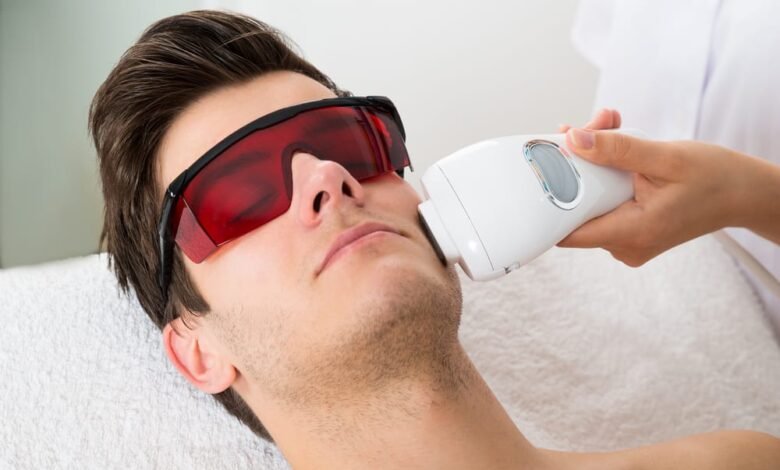A Look Beyond the Basics of Laser Hair Removal
Laser Hair Removal: A Journey to Smoother, More Confident You

Imagine a life where morning commutes aren’t a frantic dash to shave, and poolside lounging doesn’t involve last-minute razor burn checks. For many, this dream becomes reality with laser hair removal. But beneath the surface of smooth skin lies a world of complex science, evolving technology, and considerations beyond the glossy brochures. This article delves into the world of laser hair removal, exploring its effectiveness, lesser-known aspects, and the journey towards achieving that desired smoothness.
The Science Behind the Sizzle
Laser hair removal hinges on a principle called selective photothermolysis. In simpler terms, concentrated beams of light target a specific chromophore (light-absorbing molecule) within the hair follicle – melanin. The laser energy gets converted into heat, damaging the follicle and hindering its ability to produce hair. But why target melanin? Because hair, particularly dark, coarse hair, has a higher melanin concentration than surrounding skin. This targeted approach minimizes damage to surrounding tissues.
While the concept seems straightforward, the reality is more nuanced. There are several types of lasers used, each with varying wavelengths (colors) of light. The optimal laser for you depends on your skin tone and hair color. For instance, Alexandrite lasers are well-suited for lighter skin with dark hair, while Nd:YAG lasers cater to darker skin tones with a broader range of hair colors .
Efficacy: Numbers Speak Louder Than Words
Now, let’s address the million-dollar question: how effective is laser hair removal? Studies suggest a significant reduction in hair growth, often exceeding 70% after a recommended treatment course . A 2017 survey revealed that over 90% of patients reported satisfaction with laser hair removal for facial hair reduction . However, it’s important to manage expectations. Laser hair removal is a progressive treatment**, meaning it requires multiple sessions spaced out over weeks or months. The number of sessions varies depending on factors like hair growth cycle, skin type, and desired level of reduction. Most individuals require 4-6 sessions for optimal results, with maintenance treatments needed every few years.
- Underarms: Laser hair removal can achieve excellent results in the underarm area, with studies reporting a reduction of over 80% in hair growth after a series of treatments . Due to the limited number of hair follicles and a generally faster hair growth cycle, underarms often respond well to laser treatment.
- Legs: Hair reduction on the legs can also be quite successful, with studies showing a 70-80% decrease in hair growth after a treatment regimen . However, the larger surface area and potentially slower hair growth cycle on the legs might necessitate more sessions compared to underarms.
- Bikini Line: Laser hair removal in the bikini line can be very effective, although the specific results can vary depending on the desired level of hair removal (full or partial). Studies indicate an average reduction of 75% in hair growth after a series of treatments. It’s important to note that the bikini line might require more customized treatment plans due to the presence of different hair types and potential sensitivity in the area.
Beyond the Brochure: Unveiling Lesser-Known Aspects
While many articles highlight the benefits of laser hair removal, there are crucial aspects that deserve mention. Here’s what they often don’t tell you:
- Laser hair removal isn’t permanent. Despite significant hair reduction, some hair growth might return, albeit finer and lighter. This is because lasers target follicles in the active growth phase, and not all follicles are actively growing at any given time.
- It’s not a one-size-fits-all solution. Skin with a recent tan or certain medical conditions might not be suitable for laser treatment. Consulting a dermatologist beforehand is crucial for assessing candidacy and potential risks.
- Ingrown hairs can be a temporary side effect. The laser can damage the hair follicle, causing the hair to grow sideways and lead to ingrown hairs. Exfoliation and proper aftercare can help minimize this.
- Laser hair removal can be expensive. The total cost depends on the treatment area, number of sessions needed, and the expertise of the provider. While financing options might be available, factor in the overall investment before committing.
The Road to Smoothness: Prepping for Success
Preparation is key to a successful laser hair removal experience. Here are some pointers:
- Avoid sun exposure for at least 4-6 weeks before treatment. A tan can increase the risk of burns and hyperpigmentation.
- Discontinue any hair removal methods that involve plucking or waxing for several weeks prior. These methods disrupt the hair growth cycle, which can impact laser effectiveness.
- Shave the treatment area the day before your appointment. This allows the laser to target the hair follicle directly, rather than wasting energy on the hair shaft.
The Future of Smooth: Exploring Emerging Technologies
The landscape of laser hair removal is constantly evolving. Here are some exciting advancements to keep an eye on:
- Combination therapies: Combining laser treatment with other hair removal methods, like radiofrequency ablation, might enhance results and address finer, vellus hairs.
- Smarter lasers: Advances in laser technology are leading to the development of more targeted and personalized treatment options based on individual skin and hair characteristics.
The Takeaway: A Well-Informed Choice
Laser hair removal offers a long-lasting solution for unwanted body hair, but it’s not a magic bullet. By understanding the science behind it, managing expectations, and undergoing proper preparation, you can embark on this journey with realistic goals and achieve the level of smoothness you desire. Remember, a crucial step in this process is consulting a board-certified dermatologist or licensed aesthetician who can assess your candidacy, recommend the most suitable laser type.
- The Science Behind the Sizzle: delve deeper into the different types of lasers (Alexandrite, Nd:YAG, etc.) and their specific wavelengths. You could also mention melanin concentration variations in different hair colors and how that impacts laser effectiveness.
- Efficacy: Numbers Speak Louder Than Words: include statistics on hair reduction percentages for various body areas like underarms, legs, and bikini line. You could also explore the concept of maintenance treatments and how often they might be needed based on individual factors.
- Beyond the Brochure: Unveiling Lesser-Known Aspects: expand on potential side effects like blistering or crusting, although rare. Mention how these side effects are typically temporary and subside with proper aftercare. You could also delve into contraindications for laser hair removal, including certain medications and skin conditions.
- The Road to Smoothness: Prepping for Success: provide details on post-treatment care routines, including recommended moisturizers and sun protection strategies.
- The Future of Smooth: Exploring Emerging Technologies: research and discuss developments in laser technology like sapphire or diode lasers. You could also explore the potential of at-home laser hair removal devices and their limitations compared to in-clinic procedures.




